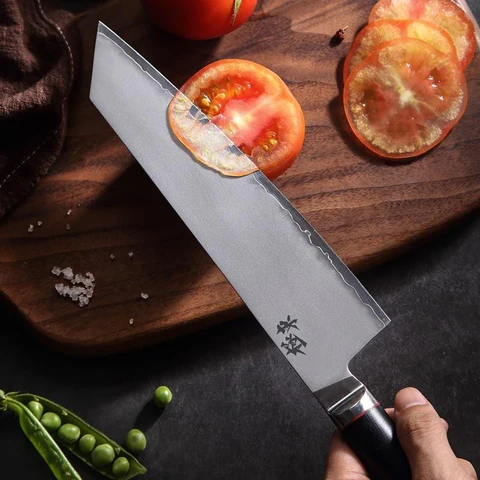Whether you're a seasoned chef or simply someone who enjoys cooking at home, understanding the features of a santoku knife can significantly enhance your culinary skills. These versatile knives are designed to provide precision and efficiency in the kitchen.

### What Sets the Santoku Knife Apart?
#### Design and Construction
The distinctive design of a santoku knife sets it apart from other kitchen knives. Typically, it boasts a shorter, wider blade with a flat edge and sheepsfoot tip, enabling better control and precise cuts across various kitchen tasks. The blade length generally ranges between 5 and 7 inches, making it easy to handle and maneuver during use.
#### Blade Material
Santoku knives are crafted from high-quality materials like stainless steel or Damascus steel, which is also known as Japanese layered steel. This type of metal is renowned for its durability and sharpness, thanks to the multiple layers fused together, creating beautiful patterns on the blade due to the layering process. An excellent example of form meeting function is the SAKUTO Japanese Damascus Steel Kitchen Knife Set with a blue handle.
### Mastering the Santoku Knife
#### Slicing
One of the standout features of the santoku knife is its ability to slice vegetables, fruits, and boneless meats cleanly. Its flat edge ensures precise cuts, making it ideal for dishes that require attention to detail, such as sashimi or carpaccio.
#### Dicing
The broad blade of a santoku knife makes dicing a breeze. Ingredients can be easily scooped up and transferred to another bowl or pan, ensuring uniform sizes for even cooking.
#### Chopping
When it comes to chopping herbs, nuts, or smaller vegetables, the santoku knife excels. The flat edge allows the entire blade to contact the cutting board, offering greater control and minimizing the risk of accidents.
### Caring for Your Santoku Knife
#### Proper Cleaning
To keep your santoku knife sharp and functional for years, it’s crucial to clean it correctly. Hand washing with mild soap and water, followed by immediate drying, is recommended. Avoid placing it in the dishwasher, as high temperatures and detergents can damage the blade.
#### Regular Sharpening
Maintaining the sharpness of your santoku knife involves regular sharpening. Using a whetstone provides precise control over the angle, but a honing rod can also help maintain the edge between sharpening sessions.
#### Safe Storage
For safe storage, consider knife blocks, magnetic strips, or protective sheaths. These methods not only protect the blade from dullness but also prevent accidents by keeping the knife safely stored when not in use.
### Choosing the Right Santoku Knife
#### Handle Design
When selecting a santoku knife, consider factors like handle shape, size, and texture. For instance, the Okugai Damascus Steel Kitchen Knife with an abalone handle combines craftsmanship with an ergonomic design, making it comfortable to hold. Similarly, the SAKUTO Japanese Damascus Steel Kitchen Knife with a colored octagonal handle offers both aesthetic appeal and superior performance.
### Common Questions About Santoku Knives
**Q: What are the three main functions of a santoku knife?**
A: The ability to slice, dice, and chop effectively are the three primary functions of a santoku knife. This versatility makes it a valuable tool in the kitchen.
**Q: How can I keep my santoku knife sharp?**
A: Regular sharpening with a whetstone or honing with a rod will help maintain its sharpness. Proper cleaning and storage are also essential for extending the life of your blade.
**Q: Can a santoku knife be used for cutting meat?**
A: Yes, it works well for cutting boneless meats. Its sharpness and precision make it ideal for preparing thin slices of meat for stir-fries or sushi.
**Q: How does a santoku knife differ from a chef's knife?**
A: While both are versatile, santoku knives have shorter, wider blades with flat edges and sheepsfoot tips, providing precise cuts. Chef's knives, on the other hand, have curved blades that allow for rocking motions, making them suitable for tasks requiring more power.
**Q: What is the best way to store a santoku knife?**
A: To ensure safety and prevent damage, store your santoku knife in a block, on a magnetic strip, or in a protective sheath when not in use.
### Conclusion
The santoku knife is an invaluable addition to any kitchen, offering versatility and precision in various cooking activities. By considering these unique features, you can streamline your cooking process and enhance productivity. Investing in high-quality options like the SAKUTO Japanese Damascus Steel Kitchen Knife Set or the Okugai Damascus Steel Chef’s Knives can provide superior craftsmanship and design, making daily cooking tasks a breeze.
Feed Probiotics
Feed Probiotics use can secrete antibacterial substances, inhibit the reproduction of harmful bacteria in the intestine, and prevent diseases. Probiotics for animals are mainly divided into lactic acid bacteria, yeast and bacillus, etc., which are often used in the breeding process. Probiotics for veterinary use can also promote the absorption and transformation of nutrients, improve the utilization of nutrients in feed, stimulate the growth of tissue mucosa, improve immunity, and reduce the occurrence of weather changes, vaccinations and other stress reactions
We are manufacturer of Feed Probiotics in China, provide Feed Probiotics,Feed Grade Probiotics,Feed Probiotics For Poultry,Feed Additives Mixed Probiotics,like Bacillus Licheniformis,Enterococcus Faecalis,Bacillus subtilis,Bacillus coagulans,Pediococcus acidilactici,Lactobacillus acidophilus,Lactobacillus Plantarum if you want to buy Feed Grade Probiotics,Feed Probiotics For Poultry,Feed Additives Mixed Probiotics please contact us.
Feed Probiotics,Animal Feed Probiotics,Feed Probiotics For Poultry,Feed Additives Mixed Probiotics,best natural probiotics for dogs
NANYANG CHENGPENG PHARMACEUTICAL CO.,LTD , https://www.chppharm.com
